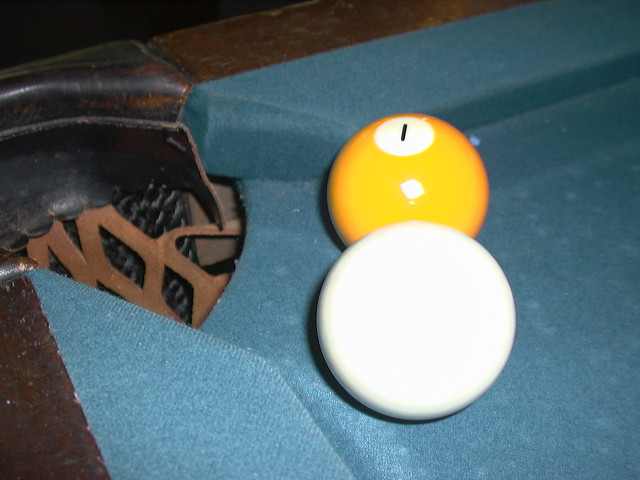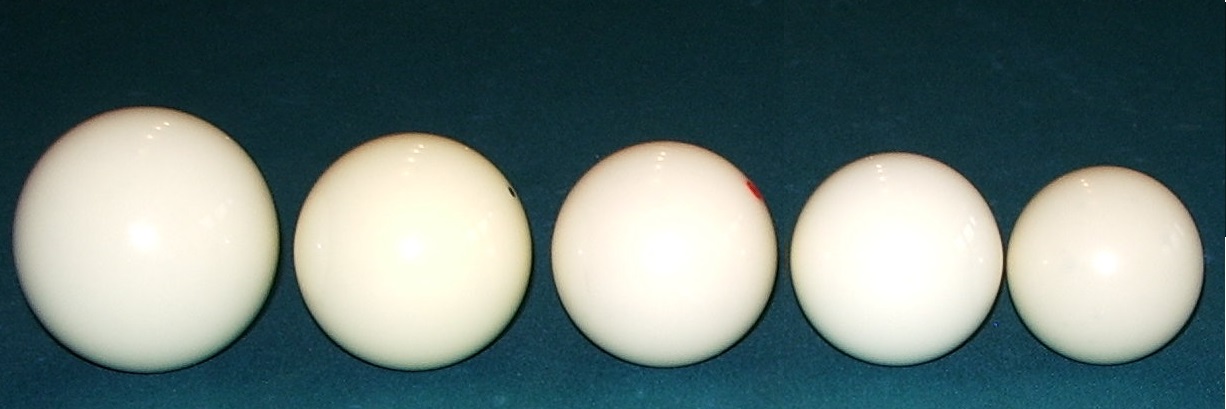|
Fifteen-ball Pool
Fifteen-ball pool, also known as sixty-one pool, is a pocket billiards game developed in America in the nineteenth century from pyramid pool. Created by members of the Bassford's Billiard & Chess Rooms in Manhattan during the late 1830s or 1840s, it is the ancestor to many American pool games. Rules The game is played on a six pocket table with a standard set of fifteen numbered and colored and a white . During the game's peak popularity from the 1870s to the 1880s, the object balls were uniformly red, though now a standard set of multi-color solids-and-stripes pool balls are used. Object balls are racked in a triangle with the 15-ball as the ball, placed at the . Behind it are the other high numbered balls with the rest in the back rows, usually in descending order. A number on a ball pocketed by a player on a legal shot scores that number of points and entitles shooter to continue at the table until failing to do so. The object is to be the first player to score at least 61 ... [...More Info...] [...Related Items...] OR: [Wikipedia] [Google] [Baidu] |
Pyramid Pool
Pyramid pool, or simply pyramids, is a form of pool that was played mainly in the 19th century. It was one of several pool games that were popular at this time, and was forerunner to modern games such as eight-ball, blackball, straight pool, and Russian pyramid. Along with black pool, it was one of the progenitor cue sports of snooker. Rules were racked in a triangle with any remaining balls placed at the back of the triangle. It could be played by several players, with an agreed stake per ball pocketed, or with just two players in which case the winner is the one to first sink over half the balls. Teams were also allowed if there were an even number of players. In early versions of the game, when one object ball remained, the game shifted so one player took possession of the original cue ball, while the other used the object ball, as they attempted to sink the other player's designated ball. This rule was dropped in the United States during the late 19th century. An early ver ... [...More Info...] [...Related Items...] OR: [Wikipedia] [Google] [Baidu] |
Manhattan
Manhattan (), known regionally as the City, is the most densely populated and geographically smallest of the five boroughs of New York City. The borough is also coextensive with New York County, one of the original counties of the U.S. state of New York. Located near the southern tip of New York State, Manhattan is based in the Eastern Time Zone and constitutes both the geographical and demographic center of the Northeast megalopolis and the urban core of the New York metropolitan area, the largest metropolitan area in the world by urban landmass. Over 58 million people live within 250 miles of Manhattan, which serves as New York City’s economic and administrative center, cultural identifier, and the city’s historical birthplace. Manhattan has been described as the cultural, financial, media, and entertainment capital of the world, is considered a safe haven for global real estate investors, and hosts the United Nations headquarters. New York City is the headquarters of ... [...More Info...] [...Related Items...] OR: [Wikipedia] [Google] [Baidu] |
Pool (cue Sports)
Pool is a classification of cue sports played on a table with six pockets along the , into which balls are deposited. "Pool billiards" is sometimes hyphenated and/or spelled with a singular "billiard". The WPA itself uses "pool-billiard" in its logo but "pool-billiards" in its legal notices. The organization compounds the words to result in an acronym of "WPA", "WPBA" having already been taken by the Women's Professional Billiards Association. Normal English grammar would not hyphenate here, and the term is actually a Germanism. A general rules booklet on pool games in general, including eight-ball, nine-ball and several others. Each specific pool game has its own name; some of the better-known include eight-ball, blackball, nine-ball, ten-ball, seven-ball, straight pool, one-pocket, and bank pool. The generic term pocket billiards is sometimes also used, and favored by some pool-industry bodies, but is technically a broader classification, including games such as snooke ... [...More Info...] [...Related Items...] OR: [Wikipedia] [Google] [Baidu] |
Pool Table
A billiard table or billiards table is a bounded table on which cue sports are played. In the modern era, all billiards tables (whether for carom billiards, pool, pyramid or snooker) provide a flat surface usually made of quarried slate, that is covered with cloth (usually of a tightly woven worsted wool called baize), and surrounded by vulcanized rubber cushions, with the whole thing elevated above the floor. More specific terms are used for specific sports, such as snooker table and pool table, and different-sized billiard balls are used on these table types. An obsolete term is billiard board, used in the 16th and 17th centuries. Parts and equipment Cushions Cushions (also sometimes called "rail cushions", "cushion rubber", or rarely "bumpers") are located on the inner sides of a table's wooden . There are several different materials and design philosophies associated with cushion rubber. These cushions are made from an elastic material such as vulcanized rubber (gum or synt ... [...More Info...] [...Related Items...] OR: [Wikipedia] [Google] [Baidu] |
Billiard Ball
A billiard ball is a small, hard ball used in cue sports, such as carom billiards, pool, and snooker. The number, type, diameter, color, and pattern of the balls differ depending upon the specific game being played. Various particular ball properties such as hardness, friction coefficient, and resilience are important to accuracy. History Early balls were made of various materials, including wood and clay (the latter remaining in use well into the 20th century). Although affordable ox-bone balls were in common use in Europe, elephant ivory was favored since at least 1627 until the early 20th century; the earliest known written reference to ivory billiard balls is in the 1588 inventory of the Duke of Norfolk. Dyed and numbered balls appeared around the early 1770s. By the mid-19th century, elephants were being slaughtered for their ivory at an alarming rate, just to keep up with the demand for high-end billiard balls – no more than eight balls could be made from a single ... [...More Info...] [...Related Items...] OR: [Wikipedia] [Google] [Baidu] |
Rotation (pool)
Rotation, sometimes called rotation pool or 61, is a pool game, played with a billiards table, , and triangular rack of fifteen billiard balls, in which the lowest-numbered on the table must be always struck by the cue ball first, to attempt to numbered balls for . Some attractions of rotation include performing unconventional or difficult shots to reach the correct ball, and quite often making risky attempts to score higher numbers of points by performing advanced shots such as , , and . Rules Object The object of the game is to score the most points, by pocketing higher-scoring balls than the opponent(s). A (individual game) is won when a player or team reaches a number of points (usually 61) that makes it impossible for the opponent(s) to win. A may consist of multiple frames (e.g. a ), or in multiple of multiple frames (e.g. three rounds of best 2-out-of-three), as in other types of pool. Scoring Points are scored by pocketing the object balls on the table; the number ... [...More Info...] [...Related Items...] OR: [Wikipedia] [Google] [Baidu] |
Cyrille Dion
Cyrille Dion (March 1, 1843 – October 2, 1878), sometimes called "''the Bismarck of Billiards''", was a top player of both carom billiards and pool during his era. Hailing from Montreal, Dion was champion of Canada in 1865. He won the last American four-ball billiards championship, held in 1873. After three-ball billiards came into vogue, he won the world championship at straight rail in 1875, and three years later, the first Championship of America at pool in 1878. He died just six months later at age 35. Tournament for the Championship of Canada Dion took first place at the 1865 Tournament for the Championship of Canada, held June 15–19 of that year at Mechanic's Hall in Montreal. It was a round robin championship at American four-ball billiards with matches to 500 points. Dion went undefeated, with a 5–0 record (''tournament results shown below''), and won a gold-mounted cue for his efforts. Tournament of State and Provincial Champions In 1866, Dion participated i ... [...More Info...] [...Related Items...] OR: [Wikipedia] [Google] [Baidu] |
Alfredo De Oro
Alfredo de Oro (April 28, 1863 – April 22 or 23, 1948) was a Cuban professional carom billiards and pool player who several times held the world title in both three-cushion billiards and straight pool simultaneously. He was posthumously inducted into the Billiard Congress of America's Hall of Fame in 1967, the first non-American to receive the honor."The BCA Hall of Fame" , , , |
Continuous Pool
Straight pool, which is also called 14.1 continuous and 14.1 rack, is a cue sport in which two competing players attempt to as many billiard balls as possible without playing a . The game was the primary version of pool played in professional competition until it was superseded by faster-playing games like nine-ball and eight-ball in the 1980s. In straight pool, the player may and attempt to pocket any object ball on the table regardless of its number or color until only one object ball and the remain, at which point the other fourteen balls are re-racked. At this point, play resumes with the objective of pocketing the remaining ball in a manner that causes the cue ball to carom into the rack, spreading out the balls and allowing the player to continue the run. The goal is to reach a set number of points that is determined by agreement before the game begins; traditionally 100 points is needed for a win, though professional matches may be higher. One point is scored by pocke ... [...More Info...] [...Related Items...] OR: [Wikipedia] [Google] [Baidu] |






_LCCN2014682795_(cropped).jpg)